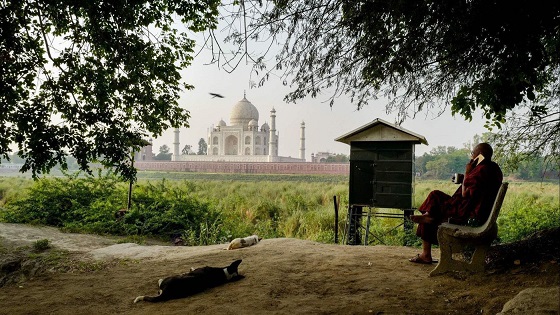정준모
How air pollution, a dying river and swarms of defecating insects threaten the Taj Mahal

Garbage covers the area by the Yamuna river near the Taj Mahal in Agra, India. (Pawan Sharma / Associated Press)
India's most famous poet, Rabindranath Tagore, once wrote that the Taj Mahal stood on the banks of the river Yamuna 'like a teardrop suspended on the cheek of time.'
One wonders whether the late Nobel laureate could have found a lyrical description of the latest threat facing the grand, white-marble monument: millions of defecating insects.
Excrement from mosquito-like bugs breeding in the heavily polluted river has stained parts of the 17th century mausoleum green, while the footsteps and palms of thousands of daily visitors have darkened the stone floors and intricately patterned walls of a structure long regarded as the pinnacle of Mughal architecture.
India's Supreme Court this month blasted the archaeological agency that oversees the monument for failing to protect it and suggested that outside experts be brought in to take over restoration efforts. During a hearing, one justice barked at a government attorney: 'Perhaps you do not care.'

In this photo from Dec. 5, 2017, scaffolding covers a marble wall of the Taj Mahal where workers applied a clay mixture to remove discoloration caused by pollution. (Manish Swarup / Associated Press)
But insect slime is only one of the problems facing the monument, built by the emperor Shah Jahan to house the remains of his favorite wife after she died while giving birth to their 14th child in 1631. Today the Taj Mahal appears less a testament to eternal love than a symbol of India's very earthly environmental troubles.
The once mighty Yamuna — after being dammed upstream to provide electricity for the region surrounding India's capital, New Delhi — now runs low and thick with trash and untreated waste, and blooms with insect-attracting algae.
Auto emissions, deforestation and crop burning have contributed to heavy smog that experts say has dimmed the tomb's pearly exterior to a jaundiced yellow. The number of cars registered in the city of Agra, where the Taj Mahal is situated about 110 miles south of New Delhi, has mushroomed from about 40,000 in 1985 to more than 1 million.
'The Taj Mahal has never looked as fatigued, pale and sick as it does now,' said Brij Khandelwal, a journalist and environmental activist in Agra.
Since the 1970s, Indian authorities have issued rule after rule aimed at protecting the country's most popular and lucrative tourist attraction, which draws more than 7 million visitors a year, 90% of them domestic tourists. They have banished coal-powered factories from the area, banned gasoline-powered vehicles near the monument and distributed cooking fuel to reduce poor families' reliance on dirtier heat sources such as wood and cow dung.
But many of the rules are flouted. And as the area surrounding New Delhi has become one of the fastest growing urban agglomerations in the world — projected to become the world's most populous city within a decade — the environmental challenges have multiplied.
Standing on the west bank of the Yamuna about a mile upstream from the Taj Mahal, Khandelwal looked out over a nearly dry riverbed filled with plastic bottles, potato-chip wrappers, empty medicine packets and other detritus.
He walked over to a derelict sewage treatment plant whose windows were broken and watched a pipe deliver effluent directly into the riverbed, foaming with chemicals as it cascaded down.
'Most of the problems emanate from this dry riverbed,' Khandelwal said. 'The original ambience of the Taj Mahal was based on the river — not just for aesthetic delight but also for its survival.'

Environmentalist Brij Khandelwal, shown here above the dry Yamuna riverbed, says time is running out to save the Taj Mahal. (Shashank Bengali / Los Angeles Times)
Like a beautician trying to smooth out wrinkles on an aging movie star, the Archaeological Survey of India, the agency that oversees the monument, has spent the last three years applying mudpacks to whiten the walls and minarets. But the grime simply returns.
'It's terrible,' lamented Manoj Sharma, 45, who has led tours of the tomb for more than a decade.
Pointing to a section of the north wall overlooking the river, Sharma said that workers had recently applied the clay mixture known as fuller's earth, traditionally used as a bleaching agent to absorb oil and grease from sheep's wool.
But just weeks later, a dark goo, believed to be from the insects, again coated the petals of flowers carved into the marble.


FAMILY SITE
copyright © 2012 KIM DALJIN ART RESEARCH AND CONSULTING. All Rights reserved
이 페이지는 서울아트가이드에서 제공됩니다. This page provided by Seoul Art Guide.
다음 브라우져 에서 최적화 되어있습니다. This page optimized for these browsers. over IE 8, Chrome, FireFox, Safari